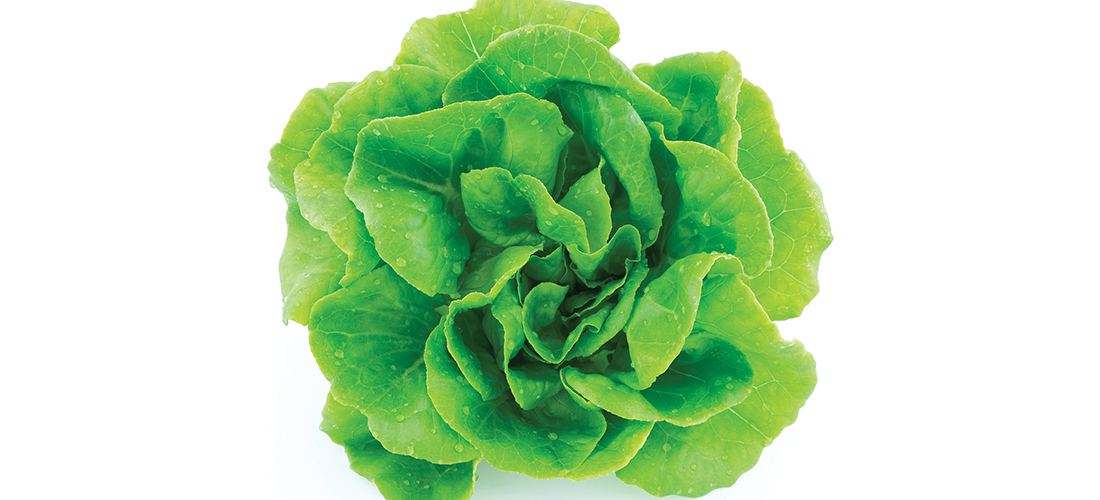
Salad Days
Make them last all spring
By Jan Leitschuh
Though our last frost date is sometime in April, we gardeners want to dig in the damp March dirt — now.
A gardener’s chilled fingers get itchy, imagining that “lamb-like” March exit, oblivious to its rude “lion” start. Those hints of spring wafting our way are intoxicating, and we ordered way too many seeds, of course.
Something has to give! The sap is rising.
If we can’t install heat lovers like tomatoes, peppers and eggplant till sometime in April — when the cold soil warms and the night temps linger softly in the 50s — what can we plant now? Lettuce.
Lettuce resists the cold and is easy to grow, even for those whose garden efforts extend to only a few flower pots or a window box. In fact, those idle porch planters would look mighty spring-like and attractive if you interspersed a few pansies or violas with some colorful lettuce transplants.
Besides your front stoop, you’ll have enough fresh leaves to dress up a sandwich. The cheerful Easter-y colors and textures are perfect for spring. Lettuce comes in lime green, speckled, burgundy, dark green, brown, ruffled, wavy, frilly, flat.
If you have a patch of good earth, so much the better. You can grow your own fresh, organic salads.
Timing is critical. Lettuce gets stressed out in too much heat. It stops growing and lacks good flavor or texture if it’s gotten too hot and stressed. While we often think of vegetables growing faster the hotter it gets, for lettuce the opposite is true.
So, get a move on! You can even try seeding a few rows in late February, sowing again in another week or two, a strategy called succession planting. I like to divide a seed packet up into four weekly plantings. In North Carolina, there are only two windows of time, in fall and spring, when natural conditions are ideal for growing these leafy greens.
One of the oldest food plants known to man, lettuce was served in ancient Greece, and was popular in ancient Rome. The word “lettuce” comes from the Latin word “lac” meaning “milk,” referring to the bitter milky juice found in mature lettuce stems.
When the European explorers sailed to the New World, they brought lettuce seeds. The first Colonial gardens planted on American soil grew lettuce. Now a side salad is ubiquitous; it’s the healthy option at lunch; and in the pre-COVID days, a potluck go-to. And we can raise it in our pots and backyards.
Choices include head and loose-leaf lettuce. I’d warn you off head lettuce for spring — the heat roars down on us, making that type of lettuce harder to grow. Have fun choosing from the colorful varieties of loose-leaf lettuce seed.
Romaine lettuce can withstand more heat than head lettuce, but will “bolt” or switch to its more bitter reproductive phase as days heat up. Butterhead or buttercrunch is a tender type of lettuce that works well here.
Otherwise, the leaf lettuces will stand more brief high temps and have a longer season of production. I plant Black-Seeded Simpson first, since it laughs at the winter cold (but doesn’t care for the heat). Salad Bowl, Slobolt, Grand Rapids, Red Sails, Freckles or Ruby lettuces do well here, among others.
Choose an area that gets four to six hours of sun. As it gets hotter in April and May, plants that get morning sun and afternoon shade will last longer and taste better. The heat can turn lettuce bitter, as the milky white sap rises from the stem into the leaves.
This bitter on the tongue is actually good for our digestion, stimulating the vagus nerve to “talk” to the gut, but bitter is not a popular flavor in modern life, so take care to cut lettuce first thing in the morning as the season lengthens. The bitterness comes from lettuce’s milky sap, activated by heat. Cutting in the cool of the morning on hotter days mitigates this.
The best soils for greens-growing are fertile, high organic matter soils that have good water-holding capacity. Water is important to lettuce, a shallow-rooted plant.
For containers, use a lightweight potting mix with included fertilizer. For the garden, spread some compost and rake it in. Lettuce loves a soil a little “sweeter” than Sandhills’ nature provides; the ideal pH is 6.0 to 6.7, so lime might be needed.
Because of its relative cold tolerance, even lettuce seedlings can handle a little freezing weather, though a hard frost can turn them to mush. An old sheet tossed on a planting bed on cold nights would not be amiss. Just remember to remove first thing in the morning. With pots, bring them into a garage or breezeway for protection on the coldest nights.
If you choose transplants from the garden center, you will have instant gratification and eye appeal. Be sure the transplants have been acclimated, or “hardened off,” and are not right out of the greenhouse.
Seeds will give you much more lettuce if you are patient. You can plant as early as February and continue through late March. Seeds are tiny, so plant about 1/4 inch deep. I sow, then sift some fine soil over the top lightly, then pat the seeds in firmly. Water gently to avoid washing away the little seeds.
After that, regular watering, especially on warm days, will keep your crop thriving and happy. Lettuce is made up of about 95 percent water, so give an inch or two when the spring monsoons aren’t available.
Your seeds will sprout and begin to crowd each other with happy abundance. Do some judicious thinning as your crop grows, and use your fresh and tender thinnings in a salad.
Depending on the weather, you’ll have a salad crop in 40 to 60 days. If you were wise and divided your seeds into two or three timed plantings, you’ll have fresh salads all spring.
As the days heat up, remember to cut your salad greens in the mornings. Cool the cut leaves in your crisper in a loose plastic bag, unwashed. Rinse just before using.
The best way to harvest loose-leaf lettuce is to pick only the outer leaves near the bottom so the plant can keep growing. For romaine or butterhead, cut off the entire head.
It’s a genuine pleasure to wander out to the garden in the morning with a cup of coffee and a knife to cut the evening’s salad greens. Whether you choose a plot, a pot or a window box, enjoy the abundance of spring. PS
Jan Leitschuh is a local gardener, avid eater of fresh produce and co-founder of Sandhills Farm to Table.





